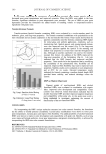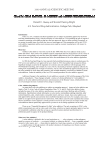18-MEA AND HAIR APPEARANCE 151 illustrated in Figure 4 (20). Figure 5 shows the schematic description of a hair fi ber, illus- trating the dorsal side versus the frontal side. The frontal side is the edge of the cuticle, which is hydrophilic, most likely, due to removal of 18-MEA by abrasion and scale chip- ping exposing the hydrophilic materials below the epicuticle. The aim of the present study was to identify the roles of 18-MEA on hair appearance, and so the WS direction was chosen for the dynamic contact angle measurements of the hair fi bers. SURFACE PROPERTIES OF HAIR IN A WET ENVIRONMENT Each fi ber was washed with a plain shampoo (15wt% of sodium polyoxyethylene lauryl ether sulfate (2.5 E.O.) with 2wt% N, N-bis(2-hydroxyethyl)-dodecanamide solution adjusted to pH7 with phosphoric acid) and cut at 5-cm intervals from the root end to the tip. Then, the relative ion yield of 18-MEA versus the CN ion yield on the outermost surface of the hair, dynamic contact angles, and friction force microscopy were measured. Advancing contact angle is the surface property that is related to the water wettability of hair fi bers going from a dry to a wet environment. Receding contact angle is the surface Figure 3. Advancing and receding contact angles for untreated hair in the “against scale” (AS) and “with scale” (WS) directions. The bars represent means for n=5 the whiskers represent the standard deviations. The asterisk symbol indicates the p-value obtained from Student’s t-test *p 0.001. Figure 4. Explanation for the receding contact angles for untreated hair being higher in the WS direction than that in the AS direction. In the receding mode the frontal edges of the scales infl uence a lower contact angle in the AS direction while the dorsal sides of the scales make a greater contribution in the WS direction, as proposed by Kamath et al. (20).
JOURNAL OF COSMETIC SCIENCE 152 property that is related to the drainage of hair fi bers during the drying process, going from a wet to a dry environment. Figure 6 shows the relationship between dynamic con- tact angles (advancing and receding) and the relative ion yield of 18-MEA versus the CN ion yield on the outermost surface of hair measured by TOF-SIMS. Squares represent the advancing contact angle and triangles represent the receding contact angle. A decrease in 18-MEA led to a decrease in both the advancing contact angle and the receding contact angle. In the case of the advancing contact angle, there were two stages in this decrease: First, when the relative ion yield of 18-MEA versus the CN ion yield decreased to 0, the advancing contact angle decreased gradually from 120° to around 100°. The correlation coeffi cient (R) and p-value (p) for the slope of the line were obtained by regression analy- sis. R was 0.76 and p was 4.0 × 10−29 (n=149). A strong correlation between the advanc- ing contact angle and the relative ion yield of 18-MEA versus the CN ion yield was observed. The slope of the approximated line for the advancing contact angle was 58.31. In the second stage, after the relative ion yield of 18-MEA versus the CN ion yield reached 0, the advancing contact angle decreased drastically from around 100° to below Figure 6. Dynamic contact angle vs the relative ion yield of 18-MEA versus the CN ion yield plot. The white squares represent the advancing contact angle and the white triangles represent the receding contact angle. Hair A, hair B, and hair C are selected for friction force investigations. Figure 5. Schematic description of a hair fi ber illustrating the dorsal vs the frontal side. The frontal side is the edge of the cuticle, which is more hydrophilic due to the hydrophilic materials below the 18-MEA layer.
Purchased for the exclusive use of nofirst nolast (unknown) From: SCC Media Library & Resource Center (library.scconline.org)





































































































































